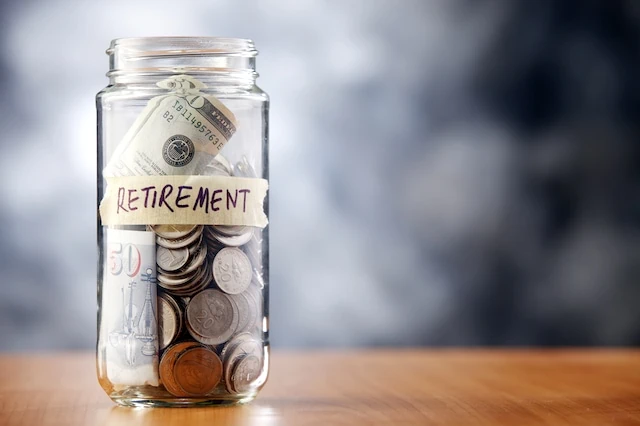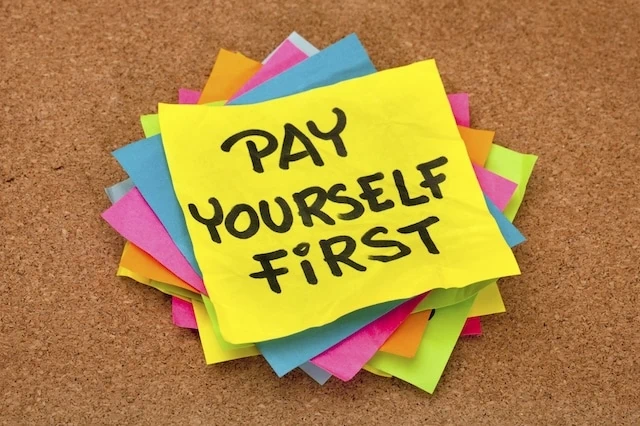While the advice to save “as much as possible” for retirement is technically good, it’s also extremely vague.
It doesn’t give you any real idea of the amount you’ll need during retirement or how much you should be saving each year to get there.
Everybody doesn’t need the same amount saved to retire, but that doesn’t mean there isn’t a way to figure out approximately how much you’ll personally need.
Let me help you figure it all out. Read on to learn how to estimate how much retirement income you’ll need, how much of your annual income to set aside each year, and how to tell if you’re currently on track with your retirement savings. I’ll also go over tips on how to maximize your savings and more.
Yes, you should save as much as you can toward retirement, but if you’re not sure how much to shoot for, start by following my concrete advice below.
Table of Contents
How Much Retirement Savings Is Enough?

When it comes to how much you need to set aside for retirement, the first thing you need to know is there’s no magic number for everyone. Retirement savings goals vary by person.
My goal today is helping you figure out how to determine your own number.
The amount of retirement income you will need depends on your planned retirement age, where you plan to live, and other factors. Fortunately, after asking yourself a few questions, you’ll be able to estimate realistic retirement goals.
Sir Arthur Conan Doyle’s famed sleuth, Sherlock Holmes, famously says, “To begin at the beginning.” In other words, if you want to know where you need to go to get where you want, you should begin at the beginning.
For this retirement savings exercise, though, I say we need the reverse—we’ll begin at the end and work our way backward. That way, we can set our desired outcome and understand what needs to happen now to get where we want later in retirement.
Use the following factors to more accurately determine how much you need to save for retirement.
Factor #1: Retirement Age

When will you retire? If you’re hoping for an early retirement, you’ll need more money saved than someone who retires at the customary retirement mark (age 65). Likewise, retiring later generally means needing less money.
Your career path might make a significant difference in your retirement age. Does your job involve hard labor that will become more challenging as you age? Or do people in your profession often continue working past the standard retirement age?
Also consider your health, life priorities, and what’s realistic for your financial situation.
Factor #2: What Lifestyle You Want in Retirement

Many people plan to maintain roughly the same lifestyle as they have during their working years. Others work hard for decades so they can live more lavishly during retirement. Do your retirement goals include frequent travel? Do you want to treat yourself to a new car or home renovations? Retirees often spend a lot of time (and money!) spoiling grandchildren.
Make sure the retirement income you’re planning for is high enough that it won’t just cover the basics, but will let you have a little fun, too.
Related: The 7 Best Vanguard ETFs for 2024 [Build a Low-Cost Portfolio]
Factor #3: Where You Want to Live

Both the city you plan to live in and the type of home you plan to stay in will affect how much money you need for retirement.
Those who currently live in a high-cost-of-living area and plan to stay there will need more money than those who plan to move to an area with a lower cost of living. If you own a large house and plan to downsize, that will help curb expenses.
However, if you rent, you should assume costs will rise over time and you might need a higher annual income for retirement than you expected. The same goes for anyone who plans to move to an expensive assisted-living facility.
Related: 7 Best Schwab ETFs to Buy [Build Your Core for Cheap]
Factor #4: 4% Rule (Or Your Personalized Safe Withdrawal Rate)

The 4% Rule is the guideline that you should withdraw only up to 4% of retirement savings during your first year of retirement. After that, you should adjust the amount for inflation each year and withdraw that amount.
Pretend your total retirement investments are worth $2 million and you expect to earn an investment return of 5.5% annually. During your first year of retirement, you would withdraw up to $80,000.
Related: How Long Will My Savings Last in Retirement? 4 Withdrawal Strategies
Now imagine inflation rises to 4% that year. According to the 4% rule, the following year you should plan to withdraw up to $83,200.
Sticking to this rule should mean you will likely have enough money to handle 30 years of retirement.
However, this is one-size-fits-most advice. It isn’t tailored to your specific situation, and you shouldn’t rely on it blindly. It includes a lot of assumptions about your retirement plans that aren’t necessarily true for you.
Even the creator of the rule, Bill Bengen, believes the 4% rule is outdated. (FYI, he now thinks it’s safe to pull more money in retirement—up to 5%. However, others think it should be less than 4%, so take all of this with a grain of salt.)
Based on your unique circumstances, you might need to withdraw more or less from your retirement savings to live the retirement you want.
Related: How Much Should I Contribute to My 401(k)?
Factor #5: Budget for 80% of What You Currently Make

During retirement, you’ll need roughly 80% of your pre-retirement annual income, provided you aren’t planning on upping your lifestyle.
For instance, if your current annual salary is $80,000, you should aim to save enough to generate at least $64,000 in retirement income per year for the number of years you expect to be retired.
Why only 80%, not 100%? For one, currently you’re stashing a good chunk of every paycheck into a retirement savings account, right? You won’t be setting that money aside once you’re retired.
Hopefully, you’ll also pay off your house, student loans, and other consumer debt before retiring. You might also have lower transportation expenses (from no longer commuting to work), you may be in a lower tax bracket (meaning you’ll owe less in taxes), you’ll be receiving Social Security, and more.
Related: The 10 Best Fidelity Funds to Own
How Much to Save for Retirement by Age

While you might already have a sense of how much you’ll need in the future, it can be challenging to tell if you’re on track saving for retirement.
Assuming you plan to retire at age 67, try to meet Fidelity’s guidelines for how much you should have in retirement savings at the following ages:
— By age 30: 1 time your annual salary
— By age 40: 3 times your annual salary
— By age 50: 6 times your annual salary
— By age 60: 8 times your annual salary
Remember, depending on what you want from retirement, the amount you will need will vary. These suggestions are based on the assumption you plan to maintain your pre-retirement lifestyle.
Don’t panic if you don’t meet all of these goalposts. There are many reasons you might not measure up on every one.
Related: Best Fidelity Retirement Funds for a 401(k) Plan
For example, if you went to college later in life to qualify for a higher-paying job you might not have your annual salary saved by 30, but you will be in a better position to save more going forward.
How Much of Our Income Should We Save for Retirement?

Plan to set aside 15% of your annual income into retirement savings, as a general rule of thumb. Whether this amount is sufficient for you depends on how you want to spend your retirement.
Related: Best Fidelity Retirement Funds for an IRA
Consider the age you’re hoping to retire, the cost of living where you plan to live, and what age you started saving.
The 15% recommendation assumes you began saving in your mid-20s. If you didn’t start saving until later in life, you might have to save a higher percentage to catch up.
Those who saved heavily in their 20s and don’t plan on an early retirement might be able to get away with a smaller percentage later in life.
Related: 5 Best Fidelity Retirement Funds [Low-Cost + Long-Term]
Tips on How to Save for Retirement

To help make the best use of your savings follow these tips:
1. Start Your Retirement Planning Early

The earlier you start saving for retirement, the more the power of compounding works in your favor. Even setting aside a small portion of your current income when you’re young can make a big difference as that money grows over the decades.
Also, long-term investments are safer, and you pay less in taxes for long-term investments than short-term, riskier investments.
Want to learn more about investing, spending, taxes, and more? Sign up for Young and the Invested’s free newsletter: The Weekend Tea.
2. Build an Emergency Fund

No personal finance plan is complete without an emergency fund. It might be tempting to invest all of your money right away, but it’s important to have liquid money available at all times.
The standard recommendation is to have three to six months’ worth of living expenses in your emergency fund.
If you lose your job, have a medical emergency, or anything else that will temporarily halt your income, you’ll be happy to have money ready.
This fund lets you avoid taking out a loan or putting your unexpected expenses onto a high-interest credit card. You don’t want to get into a cycle of debt, and if you have money set aside, you won’t.
Related: How to Negotiate Medical Bills in Collections [13 Steps to Follow]
3. Pay Off High-Cost Debt

Any high-interest debt you carry, such as credit card debt, is losing you money every month and this can add up substantially over time.
Once the debt is paid off, your living expenses will go down, and you’ll have more money to dedicate to your retirement savings every month. You don’t need to rush to pay off low-interest “good debt,” like a mortgage, but you should prioritize paying off all high-interest debt.
What qualifies as high-cost debt? Generally, it’s any interest rate higher than what you would earn if you invested the same money you’re spending on interest.
Like Young and the Invested’s content? Be sure to follow us.
4. Be Tax-Smart

In addition to setting aside enough money, be strategic about where you’re storing your retirement savings.
Tax-advantaged retirement accounts are the best place to start.
Some retirement accounts—such as 401(k)s and individual retirement accounts (IRAs)—take pre-tax income. Reducing your taxable income means you pay less in taxes that year. That saved money could be put toward your retirement savings.
These accounts let your earnings grow tax-deferred, so you don’t have to pay taxes until you take withdrawals, at which time you might be in a lower tax bracket.
Other retirement accounts—such as Roth IRAs—are funded with post-tax money, but the earnings grow tax-free. It can be useful to have tax-free retirement income. Some accounts have more benefits than others. For example, a health savings account has what’s considered a “triple tax benefit.”
Additionally, anyone who is a mid- or low-income taxpayer can benefit from the Saver’s Credit. This is a tax credit worth up to $1,000 for individuals or $2,000 for people married and filing jointly for those who contributed to a retirement account.
The credit amount varies depending on your adjusted gross income and how much you contributed to a retirement account.
Related: How Much Should I Contribute to My 401(k)?
5. Diversify Your Investments and Retirement Income

Even if you choose safer retirement investments, they need to be diversified. You can easily diversify stock market investments by putting money into mutual funds or ETFs as those contain hundreds or even thousands of stocks and bonds within them.
Related: Best Target Date Funds: Vanguard vs. Schwab vs. Fidelity
However, you want investments not correlated with the stock market as well. The stock market goes through cycles and if it’s temporarily down at the beginning of your retirement, you’ll be happy to have had other investments as well.
In addition to stock market investments, you might invest some of your retirement savings in real estate, precious metals, cryptocurrency, fine art, or other alternative investments.
Consider having both investments that earn you dividends and assets that are likely to enjoy significant capital gains.
Related: 5 Best Vanguard Retirement Funds [Start Saving in 2024]
Keep in mind that the younger you are, the more aggressive your investments can be. You might own a lot of individual stocks that have the potential for high growth.
As you get closer to your target retirement date, your overall portfolio should shift to be more conservative. You might have a larger percentage of your investments in bonds.
6. Match and Max Your Retirement Accounts

Anyone with employer-sponsored retirement plans should at least be contributing up to any matching employer contributions right away. The matching amount is free money toward your retirement.
Related: How to Get Free Money Now [15 Ways to Earn Money]
Once you can afford it, max out your retirement accounts earlier in life, rather than later, for maximum benefits.
If your job doesn’t offer a 401(k) or equivalent, there are plenty of 401(k) alternatives to choose from for your retirement savings. Some retirement accounts have low contribution limits, so you may need to supplement with other accounts or investments.
Maxing out retirement plans is a great way to offset your taxes or have more money growing tax-free.
Related: Solo 401(k) vs. SEP IRA: What’s the Difference?
7. Pay Yourself First

You just got a raise. Congratulations, now you can save more! Don’t fall prey to “lifestyle creep,” where your expenses go up whenever your annual salary increases. Instead, as you make more money, boost your retirement savings before you start spending more on recreational items and services.
Transfer money into a retirement account automatically or as soon as possible so you aren’t tempted to spend it. Saving for retirement should be part of your budget and not just a place you put “extra” money (though you can do that too).
This isn’t to say you can’t treat yourself on occasion, (you can!), but if you aren’t sufficiently saving for retirement, you’re living outside your means.
Related: The 7 Best Fidelity Index Funds for Beginners
8. Catch Up

Everyone doesn’t start saving for retirement in their 20s, and even those who do may want to contribute more to tax-advantaged accounts.
Many, but not all, retirement accounts allow catch-up contributions for people 50 and older. For example, a traditional or Roth IRA allows up to $1,000 in catch-up contributions each year, and 401(k) plans currently allow annual catch-up contributions of up to $7,500.
Once you turn 50, see if the contribution limits for your retirement plans have risen and max out your new limit.
Related: How to Max Out Your 401(k) + Other Retirement Accounts
9. Don’t Count on Social Security Benefits for Your Retirement Planning

Don’t risk relying on Social Security benefits when federal budget deficits continue to climb, and more people retire. While most experts say Social Security won’t run out of money, for my own retirement plans, I’m preparing for the worst.
Related: Don’t Believe These 17 Social Security Myths
Even if it doesn’t run out of money, a Social Security check isn’t enough money to sustain a person during retirement. As of August 2023, the average monthly benefit was about $1,700. Try living on that.
It’s always recommended to have ample other savings. Medicare doesn’t cover all of your health care expenses and you’ll still have plenty of other costs.
Related: How Are Social Security Benefits Taxed?
To be safe, assume you won’t be getting Social Security during retirement. Then, if you receive a small amount, it will be a bonus and not money you rely on to pay your bills.
10. Consider Speaking With a Financial Advisor

Financial advisors can assist with building your retirement savings plans. Consider talking to financial advisors at several points of your retirement savings journey.
These advisors can help you calculate whether you’re on track for retirement or if you should be setting aside a higher percentage of your annual salary.
They can help evaluate your current investments to see if they align with your goals and risk tolerance.
You might also want to ask a financial advisor about investments that can diversify your current portfolio. If you don’t want to pay a financial advisor to run your investments, consider looking into robo-advisors as an affordable alternative.
Related: SEP IRA Contribution Limits [2024]
Should I Max Out My 401(k) in My 20s? 30s?

Whether you should max out your 401(k) in your 20s and 30s depends on your financial situation. If you can afford to do so, you should absolutely max out your 401(k) when you’re young, since you can benefit the most from compound growth in those early years.
Always contribute enough to get the maximum employer match, since the match is considered free money.
Next, a good strategy is to max out a health savings account (HSA)—if you’re eligible—and an individual retirement account (IRA) to take advantage of the tax benefits those accounts offer.
If you can afford to invest more after that, maxing out your 401(k) is an excellent choice in your 20s and 30s. Setting more aside might mean you have to live a bit more frugally now, but the earnings can be worth it in the long run.
Just make sure you also have enough to pay your monthly bills and have an emergency fund in place, since you don’t want to make early withdrawals from a 401(k) account.
Like Young and the Invested’s content? Be sure to follow us.
The Younger You Are, The More Compounding Works for You

People who begin investing when they’re young have a substantial advantage over those who don’t start until later in life. In general, the longer money is invested, the more time it has to grow.
Workers who invest heavily in a 401(k) plan early in their careers have time on their side. Thanks to compound interest, money in their 401(k) can grow significantly by the time they reach retirement.
If you wait until you’re older to start making 401(k) contributions, you miss out on a lot of growth and have to invest more overall money to have the same amount in the end.
Related: How to Invest in Your 20s [Best Ways to Start Investing Money]
Please Don’t Forget to Like, Follow and Comment

Did you find this article helpful? We’d love to hear your thoughts! Leave a comment with the box on the left-hand side of the screen and share your thoughts.
Also, do you want to stay up-to-date on our latest content?
1. Follow us by clicking the [+ Follow] button above,
2. Subscribe to The Weekend Tea, our weekly newsletter to read more about investing, spending, taxes, and more, and
3. Give the article a Thumbs Up on the top-left side of the screen.
4. And lastly, if you think this information would benefit your friends and family, don’t hesitate to share it with them!





